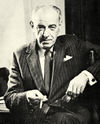The High Wire
The High Wire is a 1963 suspense novel by the British author William Haggard published in England by Cassell and in the United States by Ives Washburn. It was Haggard's fifth of 21 books involving his urbane protagonist Colonel Charles Russell, the head of the unobtrusive but lethal Security Executive, a government counterintelligence agency clearly based on the actual MI5 or Security Service, where he moves easily and gracefully along C.P. Snow's Corridors of Power in Whitehall. It has noticeably less detailed examinations of character and motivation than Haggard's four earlier books and considerably more elements of standard suspense thrillers, particularly regarding action and gun-play. Haggard had achieved a certain critical reputation by 1963, and High Wire only added to it: the Crime Writers' Association of the United Kingdom gave it runner-up status for that year's Gold Dagger, their annual award for the best crime novel of the year. Gun Before Butter by Nicolas Freeling was the other runner-up, while the Gold Dagger itself went to one of the most famous thrillers ever written, The Spy Who Came in from the Cold by John le Carré. Haggard's book is also notable for its sardonically malicious depiction of the President of an unnamed country across the English Channel, a tall, grandiose, and mystique-driven Marshall who clearly evokes Charles de Gaulle.
Plot
Protagonist is perhaps too strong a word to describe Colonel Russell. As Haggard himself wrote about his fiction:
My novels are chiefly novels of suspense with a background of international politics. A Colonel Charles Russell of the Security Executive, a not entirely imaginary British counter-espionage organization, while not a protagonist in the technical sense, holds the story line together in the background by his operations, while the characters in the foreground carry the action."[1]
As usual with Haggard's books, his understated prose and the elegant upper-stratum world of most of his characters belie the violence that lurks not far beneath the seemingly placid surface. Sir William Banner, a highly successful industrialist and jovial bon vivant, has hired Rex Hadley to be the chief production engineer at Maldington, a new, top-secret, and ferociously guarded plant not far from London where development is underway on Project A, a non-nuclear explosive that, if successful, will be 10 to 12 times more powerful than those presently being used by militaries around the world. But before taking up his new post, Hadley is ordered by Banner to take a vacation at the Italian ski resort of Sestriere. There Hadley is befriended by Francis de Fleury, a high-level French intelligence agent and his Central European mistress. Once back in England, de Fleury begins to try to draw Hadley into his circle. Unbeknownst to de Fleury, however, his charming mistress, Mary Francom, is actually an operative for Colonel Russell of the Security Executive, whose brief it is to protect Maldington and its employees by all possible means. Victor, the one-armed but murderously brutal head of a French espionage agency, is ordered by his master, the grandiose President, to secure the secrets of Project A at any cost. Ignoring the more delicate operation against Hadley already put in place by his subordinate and fellow-countryman de Fleury, Victor mounts a nocturnal war-like strike against Maldington involving helicopters, soldiers, land-mines, deliberate murders, and potential kidnappings of key personnel. At the cost of several lives, the Executive thwarts Victor's operation and so for the moment de Fleury's plans to blackmail Hadley into cooperation come to the forefront. But these too are thwarted, by Sir William Banner and Colonel Russell acting together, and Hadley returns to Sestriere for yet another skiing vacation, closely watched this time by both British and Italian intelligence and police agents. Victor, however, with nothing to lose, crosses the nearby border and manages to isolate both Hadley and his now-girlfriend, Mary Francom, in a stalled cable car high in the Italian Alps. There he intends to torture Hadley into revealing what Victor thinks are the secrets of Project A. Fortunately for Sir William Banner and the developments at Maldington, both the "invaluable" Major Mortimer of the Security Executive of earlier books and the now-renegade Francis de Fleury are in near proximity on the ground below and a determined Mary Francom is in the disabled ski lift. Between them, they bring to the book to Haggard's usual violent dénouement.
Reception and/or Appraisal
The New York Times review was highly favorable:
...now appears THE HIGH WIRE (Washburn, $3.50) to appeal to all who are willing to detach themselves from James Bond and enjoy something more nearly approaching the melodramatic realities of the secret war against security. More of a straight spy-thriller and less of a novel of character than most Haggard books (though its people are by no means scanted), "The High Wire" is especially commended to those who are weary of the standard villains of most tales of intrigue... This is precisely managed thriller-mongering, sardonic and acute.[2]
